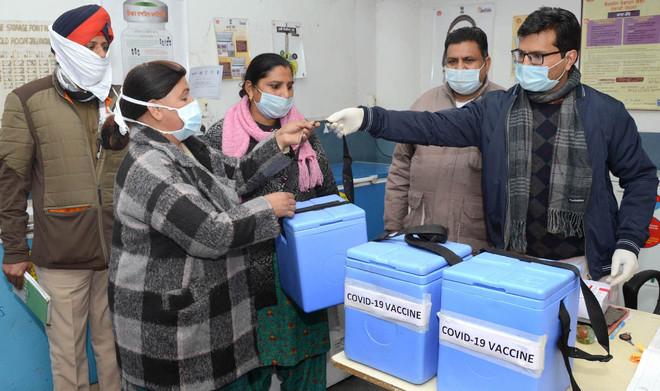Present Vaccination Drives Will not Dent the Omicron Wave - India Still Short of Vaccinating the Population

Officials of Jalandhar Civil Hospital hand over the vaccine to the staff of community health centres
At the start of the new year, the government announced the rollout of vaccination for the 15-18 year age group from January 03, 2022, and precautionary dose for identified vulnerable categories (healthcare workers and frontline workers and co-morbid 60+ group) from January 10, 2022.
However, the targets for vaccinating different sections of the Indian population are still incomplete. A significant proportion of the adult population (18 years and above), especially the 60+ years age group, is still unvaccinated or partially vaccinated.
The present vaccination drive with precautionary doses will not immediately help control the current rise of cases due to Omicron. This wave will probably pass well before precautionary doses (for), or children's vaccination has any significant effect. The government needs to focus more on vaccinating those adults who are, even now, unvaccinated (no doses at all) or partially vaccinated (with only one dose).
Moreover, with the Omicron variant of the SARS-Cov2 virus spreading fast across India, the government needs to adopt a multi-pronged approach. On one hand, the vaccination rate needs to be ramped up, and on the other, the government must implement localised public health strategies to curb the spread of the virus.
With new sections of the population getting started to get vaccine jabs, we look at the extent to which vaccination has been completed in other categories that had begun in 2020. Looking at the progress made in each population category, we try to assess the timelines that each category may follow to get fully vaccinated.
As of January 17, the total requirement includes –
- Nearly 99 million beneficiaries in the age group of 15-18 years will require about 198 million doses (two doses). With about 35.7 million administered to date, about 162 million more are needed.
- There are about 940 million people as part of the adult population (above 18 years of age). Out of this, nearly 215 million people still need the second dose, and 92.7 million people are unvaccinated and require both doses (185.4 million doses); that is, a total requirement of about 400.4 million doses.
- There are around 30 million HCWs and FLWs who would need the precautionary dose in a staggered way. They can get the third dose only after 39 weeks of getting their second dose. Of these 30 million, 3.3 million have been administered.
- There are around 135 million people in the 60+ years category. They would also need the precautionary dose in a staggered way - after 39 weeks of getting their second dose. Of these 135 million, 1.1 million have been administered.
Below we discuss the time taken to vaccinate each category, given the dose-gap restrictions. We try to assess these timelines, considering the average vaccination rate over seven days, which is different for different categories of the population getting vaccinated. This analysis assumes that the supply of vaccines will be forthcoming, and the vaccination drive will run smooth with people from all categories coming forth for their vaccination.
By When is Each Category Expected to Get Vaccinated?
The 15-18 years Age Group
The current rate of vaccinating the 15-18 years category is about 2.1 million/day. The per-day rate has been calculated by looking at the vaccination trends for the first 14 days since the vaccination started on January 3.
There are a total of about 99 million people in this age group. At this rate, the first dose of vaccine for the people falling in this category will complete in about a month by early or mid-February 2022. As only Covaxin is being administered in this age group, the drive for the second dose will likely begin only by mid-March to the end of March 2022. Figure 1 shows the trajectory of first dose vaccination to this age group.
Figure 1:
The Adult Population – 18+ Age Group
For this age group, there are still nearly 400.4 million doses required for fully vaccinating all the adults- with 215 million needing the second dose and 92.7 million needing both doses (185.4 million doses). Taking a span of 14 days, the rate of the first dose of vaccination is 13 million/week and the second dose of vaccination 22 million/week.
At this rate, for nearly 940 million adults, the first dose of vaccination is expected to complete by the second week of March 2022 and the second dose by the end of April. Figure 2 plots the trajectories separately for the first and second doses against the targets.
Figure 2:
Precautionary Dose for HCWs and FLWs
As there has to be a gap of 39 weeks between the second dose and the precautionary dose, only those HCWs and FLWs were eligible on January 10, the day the precautionary dose drive started, who had received their second dose of vaccination by April 12, 2021. The precautionary dose will be administered at a rate in accordance with the completion of these workers' second dose 39 weeks ago.
Taking a month-wise scenario, from January to February 2022, only about 14% of HCWs and FLWs will be able to get their precautionary doses. A total of 17% of the total population of HCWs and FLWs will get a precautionary dose by March. And by April, about 23% of their population would be able to get vaccinated.
Precautionary Dose for 60+ Age Group
For this age group, the precautionary dose is also to be administered after a gap of 39 weeks from the second dose. Assessing the time when people in this age group got their second dose 39 weeks before January 10, 2022, we find that by February, only 10% of the 60+ population would get their precautionary dose. By March 2022, only 13% would have gotten the third dose, and by April 2022, only 19% would get the precautionary dose.
The precautionary doses for these two categories of the population – HCWs & FLWs and the 60+ age group – were started from January 10. The current rate of administering precautionary doses is about 0.19 million doses/day. Figure 3 plots the trajectory of targets and achievement in precautionary doses for the next three months.
Figure 3:
Challenges
At present, there are several challenges to complete vaccination of the entire Indian population. In the best-case scenario, only a small fraction of the more vulnerable population (60+ years and HCWs and FLWs) would be able to get vaccinated with their third dose or the precautionary dose in the next 3-4 months. Meanwhile, we still have a substantial adult population that remains to be administered either the first or the second dose. In addition, there are about 4.5 million HCW and FLWs which remain to be fully vaccinated before being administered the precautionary dose.
Moreover, the stipulation of using only Covaxin for inoculating the 15-18 years age group and using the same vaccine for precautionary dose as was used in the first and the second dose (Covaxin or Covishield) means increased requirement for the Bharat Biotech's vaccine, Covaxin.
In December 2021, the Central government had informed that the current capacity of Bharat Biotech to produce Covaxin is about 45 million doses/month. This would certainly put some brakes on the vaccination rate given the increased requirement of Covaxin. Till December 30, 2021, only 155 million doses of Covaxin were administered, mainly due to supply constraints.
Clearly, the vaccination targets are still lagging far behind, and the government needs to ensure that vaccination rates pick up. The government needs to focus on vaccinating the adult population (18 years above), which is still 92.7 million unvaccinated and 215 million who need the second dose.
The pace of precautionary doses will be determined by the speed at which the second dose was administered in 2021 to HCWs & FLWs and the 60+ age group. As it will take some time for those getting precautionary doses to get their immunity built up, the current vaccination will not dent the ongoing pandemic wave. The government needs to adopt more localised public health measures to contain the outbreak and spread of the pandemic in different pockets of the country.
(Support with data and visualisations provided by Peeyush Sharma and Pulkit Sharma of NewsClick Data Analysis Team)
Get the latest reports & analysis with people's perspective on Protests, movements & deep analytical videos, discussions of the current affairs in your Telegram app. Subscribe to NewsClick's Telegram channel & get Real-Time updates on stories, as they get published on our website.
























